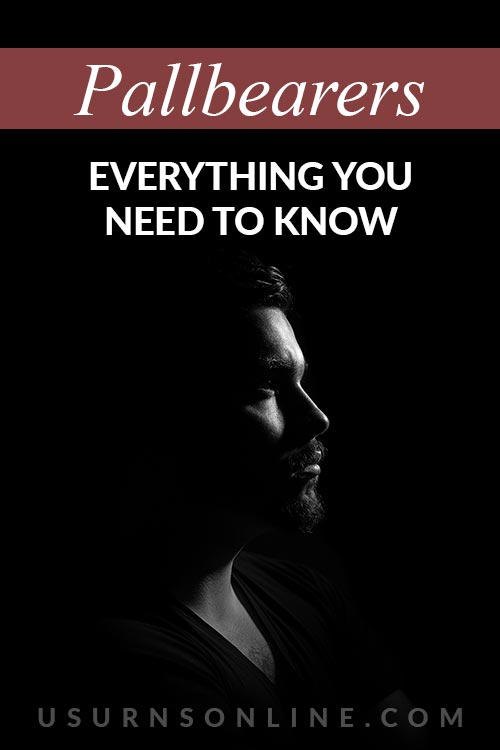So, Grandma has asked you to be a pallbearer for Grandpa’s funeral. Don’t hesitate to accept the role of pallbearer. It’s a time-honored tradition.
If you’ve never carried a casket, don’t worry. We’ve put a bunch of information together for you. Once you have finished reading this article, you will be able to give all of the other pallbearers a lesson!
What Is a Pallbearer?
A pallbearer is a person helping to carry or officially escorting a casket at a funeral.
How many pallbearers are there?
Usually there are six pallbearers, sometimes eight.
With six pallbearers, there would be three on each side. With eight, the extra two people would be on either end of the casket.
What are a pallbearer’s duties?
A pallbearer transports the remains of the deceased from one location to another.
For example, the pallbearers will carry the casket from the hearse to the church. After the funeral service, they will bear the casket from the church back to the hearse. Upon arriving at the cemetery, the pallbearers will carry the casket from the hearse to the gravesite.
How heavy is a casket?
Caskets can range from as little as 60 pounds to as much as 400 pounds or more. The weight will depend on the type and quantity of materials used.
Plywood with wood veneer makes the lightest and least expensive caskets.
Pine is considered light at about 150 lbs, whereas mahogany and cherry are the heaviest woods coming in at about 250 lbs.
Urns Made in the USA
Metal caskets will vary in weight from 160 to 200 pounds. The gauge of the metal and the type of metal will make the weight difference. 18-20 gauge steel is the most popular choice for a metal casket. Copper, bronze, and gold can also serve as materials for caskets. Gold caskets are the heaviest and priciest models of caskets.
These weights are from empty caskets. Of course, the body adds a considerable amount of weight.
If you figure an average adult weight of about 200lbs, plus an average casket weight of 200 lbs, that’s a total of approximately 400lbs. Divided among six pallbearers, each individual will bear roughly 66 lbs. That is not an inconsequential weight, but very doable.
What should pallbearers wear?
Pallbearers should dress conservatively; dark suit and tie, pantsuit, or dress. Wear clothing that is comfortable and that you can move in. You will be stretching, bending, and lifting.
Pallbearers should wear flat shoes, so they don’t trip while carrying the casket. Aside from these considerations, traditional funeral attire is most appropriate.
I have conducted funerals where the pallbearers all wear identical outfits. I’ve also been to funerals that the pallbearers will wear the decedent’s favorite color. An example would be red shirts and black pants.
Pallbearers wear white gloves on occasion, but not always. The funeral home will provide the white gloves.
What is an honorary pallbearer?
An honorary pallbearer is given recognition but is not required to assist in carrying the casket. The status of honorary pallbearer is kept for friends or relatives who are elderly, who otherwise could not bear the weight, or those not chosen for the first six.
Can honorary pallbearers be deceased?
The honorary pallbearers don’t participate in carrying the casket, so why not? If a close friend died recently, it is perfectly acceptable to name them posthumously as an honorary pallbearer.
Do you have pallbearers at a cremation?
A traditional pallbearer is not necessary for people who have chosen to be cremated. Although you might select honorary pallbearers to walk alongside or behind the person carrying the urn.
How are pallbearers chosen?
Anyone can serve as a pallbearer. However, pallbearers are usually close family members and friends. Siblings, adult children, grown grandchildren, nieces and nephews, close friends, and colleagues are typical for pallbearers.
Can you have female pallbearers?
Yes, a woman can be a pallbearer. It’s an honor to be a pallbearer just as much so for a woman as for a man. But, unfortunately, it isn’t often that women are pallbearers.
10 Tips for Serving as a Pallbearer
1. Remember that serving as a pallbearer is an honor.
To be chosen as a pallbearer shows that the family trusts you. After all, you are accompanying their loved one to his/her final resting place. Carrying the casket is a privilege. And as such, you should treat the position with respect and dignity.
2. Dress appropriately.
Men should wear a dark, solid-colored suit and white shirt, with a tie that isn’t too colorful is the best bet. Women should wear a dark pantsuit or dress.
The family will usually provide boutonnieres for the ushers to wear. The wearing of a boutonniere will distinguish you from other guests. If the family requests that you wear white gloves, do so.
3. Turn off your phone.
This should be a rule for everyone at a funeral. A phone ringing during a funeral service is one of the most disrespectful things I have ever witnessed as a funeral director. The use of phones during a funeral service is a pet peeve of all funeral directors. Please. Turn. Off. Your. Phone.
4. Being nervous about carrying a casket is normal.
Pallbearers are essential to most funerals, and all eyes will be on you. So do your best, and no one can fault you. Follow instructions, be in your place at the correct time, and behave appropriately.
5. Watch your step and wear sensible shoes.
Usually, if everybody takes it slow, you’ll do fine together. However, if you’re trying to move too quickly or take large steps, you might crowd another pallbearer or step on their heel.
If one of the pallbearers trips, everyone should stop long enough to allow them to get their footing, then continue.
6. Follow the funeral director’s instructions.
Even if you think your way is better because you’ve been a pallbearer before — the funeral director has done this repeatedly and knows best.
A funeral is not your time to shine; it’s about the family and the decedent. Even if your way really is better, it’s most respectful to simply follow the instructions and allow yourself to be a small part of something bigger than yourself.
7. Arrive on time or, better yet, be early.
It would be best if you were sure to arrive at or before the time specified. The funeral director will have instructions for you, and you may have some unanswered questions.
Arriving on time or early means that you will be prepared and know when and where to go and how to go about it.
8. Try to keep your emotions under control.
If you’re overcome with emotion and crying, you will find it’s more challenging to carry out your tasks. Take a few deep breaths and try to keep yourself calm. Crying is ok, but at the same time, the work of a pallbearer is important and will require focus.
9. Be prepared for heavy lifting.
You should make it known when you’re asked to be a pallbearer if you can’t physically complete your duties.
10. Stay back and support the family after the funeral is over.
A pallbearer shouldn’t rush to leave as soon as service is over. Instead, hang around for a while and offer support and comfort to the family. Go to the reception, talk to family and friends, and honor the memory of your departed loved one.
Now that you have read all of our tips, hopefully, your nerves are calm, and you are ready to take on this honor!
Next: Funeral Etiquette: What to Do & What to Say
Pin It




